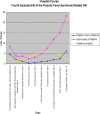Periodic fever syndrome with relapsing glomerulonephritis: a case report and teaching points
- PMID: 25984185
- PMCID: PMC4421743
- DOI: 10.1093/ndtplus/sfr080
Periodic fever syndrome with relapsing glomerulonephritis: a case report and teaching points
Abstract
We report a case of relapsing mesangial and endocapillary proliferative glomerulonephritis (GN) associated with a periodic fever syndrome. The patient presented 11 times in >4 years with acute febrile episode followed in 1-3 days by hematuria, thrombocytopenia and other symptoms of acute GN with variable severity of acute kidney injury. In three episodes, the patient required renal replacement therapy for 7, 10 and 2 treatments, respectively. Shortly after the acute symptoms of the febrile episode had resolved each time, the kidney function would recover and the serum creatinine would return to baseline. Two kidney biopsies obtained during separate episodes showed acute tubular injury along with morphological changes resembling post-infectious GN but with no clinical evidence to support an infectious etiology. Multiple treatment regimens were unable to control the disease. Symptoms were alleviated by rituximab but did not completely remit. Stable remission of the periodic fever and GN was finally achieved after anakinra therapy was initiated 18 months ago. Since then, the patient had several episodes of documented infection without high fever and nephritic kidney manifestations. His kidney function remained stable with normal serum creatinine.
Keywords: autoinflammatory reactions; glomerulonephritis; periodic fever.
Figures



References
-
- Watanabe T, Yoshizawa N. Recurrence of acute poststreptococcal glomerulonephritis. Pediatr Nephrol. 2001;16:598–600. - PubMed
-
- Casquero A, Ramos A, Barat A, et al. Recurrent acute postinfectious glomerulonephritis. Clin Nephrol. 2006;66:51–53. - PubMed
-
- Glotz D, Jouvin MH, Nochy D, et al. Recurrent acute glomerulonephritis. Am J Kidney Dis. 1991;17:228–230. - PubMed
-
- Yoshizawa N. Acute glomerulonephritis. Intern Med. 2000;39:687–694. - PubMed
-
- Sawanobori E, Umino A, Kanai H, et al. A prolonged course of group A streptococcus-associated nephritis: a mild case of dense deposit disease (DDD)? Clin Nephrol. 2009;71:703–707. - PubMed
LinkOut - more resources
Full Text Sources
